
    
Welcome
to my recently revised Peter Lorre
pages. I now have a links
page and a new photo gallery
is in the works in addition to the
film page and list of television
appearances. They've all been moved
from their previous locations on
Geocities to the current Velvetsofa.com
locations. If you visit the old
main page you'll just be directed
here. In the future I'll be adding
a list of radio credits, lobby card,
poster, and memorabilia pages, and
whatever else occurs to me. So please
come visit again.
I'm
not sure how it crept by me, but
The Lost One: A Life of Peter
Lorre, the long awaited, definitive
biography of Peter Lorre by Stephen
D. Youngkin (co-author of the indispensible
The Films of Peter Lorre)
was released last September. I finally
received my copy today. It's impressive.
The little biography
I wrote (below) pales embarassingly
in comparison. At 500+ pages it
may take a few days to finish it.
The book also has an Official
Web Site.

The
Lost One:
A Life of Peter Lorre 
|
You
can find the list of Peter Lorre films
showing on U.S. Cable this month listed
here
at TV-Now.com. Below is my own feature
of the month.
This
month's featured DVD is Roger Corman's
The Raven also starring Vincent Price
and Boris Karloff.

The
Raven
Peter
Lorre was teamed with two horror greats
in this pop gothic spoof. Good guy
sorcerer Price is cajoled by friend
Lorre (who's been transformed into
the title bird) to visit the castle
of conjurer emeritus Karloff; Price
and Karloff end up in a black magic
duel.
USA, 1963, Color, 86 minutes.
|

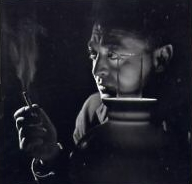
You
already know Peter Lorre, or at least
are peripherally aware of his existence.
His screen personality is a common
caricature in our culture. Despite
being dead for over forty years, Peter
Lorre is still imitated and the characters
he created used as a blueprint. (For
example we have the cartoon Ren
and Stimpy. Let’s face it, Ren
is Peter Lorre.)
Although the memory of his screen
presence is indelible, still most
people are unaware of the man behind
the character and his life story.
|
Peter
Lorre was born Ladislav Löwenstein
on June 26th 1904 in Rozsahhegy, Hungary
(in what is now Slovakia) to Alois
and Elvira Löwenstein. (Some incorrect
biographies give his birthplace as
Transylvania, perhaps in view of his
unwanted image as a horror movie actor.)
Peter’s mother died in 1908, and his
family moved to Romania and then to
Vienna, and during the first world
war to a farm in Austria. When that
particular part of Austria became
a part of Yugoslavia, the family returned
to Vienna. Peter had already formulated
the goal of acting as a career. |
|
Although
Lorre tried his hand at being a
bank teller, to please his father,
he soon gave it up to devote himself
completely to acting. It has been
erroneously, and perhaps facetiously,
reported in a bio elsewhere on the
net, that Peter was a psychiatrist.
It would have been a good trick
since he was 26 years old when he
made M and had been in the theater
for years before that. However,
the rumor could have sprung from
the fact that one of his first acting
jobs was with a theatre group specializing
in psychodrama; the use of acting
as a psycho-therapeutic device.
It was in this period that Peter
changed his name from Ladislav Löwenstein
to Peter Lorre.
In
1924, Peter moved to Breslau (now
Wroclaw, in Poland) to work in the
theater there, and then to Zurich,
but by 1925 returned to Vienna.
He appeared in local productions
there until 1928 when he went to
Berlin. He was immediately cast
in a play, Pioniere in Ingolstadt
as the village idiot and received
rave reviews. At this time he met
his first wife, Celia Lovsky. He
also became seriously ill and had
to undergo major surgery. The end
result was life long health problems
and an addiction to morphine. Peter
continued to appear in large roles
on the Berlin stage; Happy End,
Danton’s Tod, Kindertragoide
and then in Fruhlings Erwachen
[Spring’s Awakening]. It
was in this play that director Fritz
Lang first saw Peter. Lang immediately
offered Lorre a role in Lang’s first
sound film.
|

Peter Lorre in
M
|
While
waiting for the film to reach the
shooting stage, Peter continued to
appear in theater productions; Die
Unuberwindlichen and Die
Quadratur des Kreises. In 1931
Peter made the movie with Fritz Lang.
It was M, the story of the
search for a child murderer. As the
killer, Lorre’s performance was chilling,
pathetic and convincing. It also brought
him international attention and, as
usual, great reviews. |
He
appeared in several other German films,
in parts that ranged from little more
than extra work to large supporting
roles. Just before Peter began work
on his ninth film he was forced to
flee Germany. Although under no immediate
threat from Hitler’s master plan,
it would only have been a matter of
time, being a) Jewish b) foreign and
c) a creative intellectual. In any
case all of his co-workers were leaving
the country to avoid persecution and
the rapidly growing censorship. |
| Peter’s
ninth film was finished in Vienna.
He and Celia then moved to Paris,
where he made only one film. In 1934
Alfred Hitchcock sought him out to
play the role of the terrorist in
The Man Who Knew Too Much.
Though Peter claimed to have known
no English at the time he was cast,
he picked it up quickly enough to
give a multi-layered and sinister
performance in the film. He and Hitchcock
were said to have gotten along famously,
both having a penchant for practical
jokes. During the filming in England,
Peter and Celia were finally married.
|
|
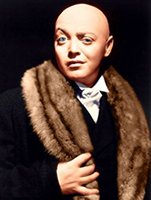 |
Peter
was soon offered a contract by Columbia
Pictures in America. He accepted it
and sailed to the United States. Unfortunately
Columbia didn’t quite seem to know
what to do with him and his first
American movie was for MGM, Mad
Love, in which he was typecast
as an insane killer. In return Columbia,
accepted Peter’s suggestion that he
play the part of Raskolnikov in the
film version of Dostoyevsky's Crime
and Punishment. The movie was
an interesting experiment, but not
a popular success. Peter returned
briefly to England to appear in another
Hitchcock film, Secret Agent.
|
When
he returned to America he left Columbia
and signed with the relatively new
Twentieth-Century-Fox. His first role
there, as Colonel Gimpy in Crack-Up,
afforded him the opportunity to do
comedy as well as drama. His next
project was certainly a departure
from his previous characters. He was
cast as the Japanese detective, Mr.
Moto, based on the character in the
John P. Marquand novels. The studio
had been successful with their other
Oriental sleuth films, The Charlie
Chan Series, and in good Hollywood
tradition, set out to copy the concept.
Always beneath the surface of Lorre’s
Moto was a threatening edge that made
the character far more interesting
than most of Hollywood’s other series
detectives. |
|
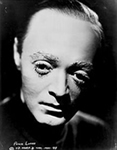
The Face Behind the
Mask |
This
ability to give subtle shading to
his acting was a key to Lorre’s success.
All his villainous roles have a darkly
humorous touch, while his light or
comedic performances featured a sinister
undertone. The slight twist in his
performances gave them a tension that
continues to tantalize audiences.
Most of Lorre’s starring roles were
in B features, where he was often
teamed with Sydney Greenstreet, although
a number of these films were better
than typical Hollywood A product. |
For instance Lorre added a judicious
amount of pathos to his role as
a vengeful, disfigured immigrant
in The Face Behind the Mask (1941)
turning the film into an eloquent
statement about the failure of the
American Dream. Throughout the 1940s
Lorre added color to films in numerous
supporting roles, notably in Warner
Brothers films, as Joel Cairo in
The Maltese Falcon (1941) and Ugarte,
the obsequious black marketeer,
in Casablanca (1942).
By
the end of the decade, Lorre’s face
and silken voice had become so recognizable
that he was caricatured in Warner
Bros. cartoons and on Spike Jones
records. He even successfully parodied
his “image” in films like Arsenic
and Old Lace (1944) and My Favorite
Brunette (1947), yet he was never
reduced to parodying himself.
|
| In
1950 he returned to Germany where
he co-wrote, directed and starred
in Der Verlorene, (The Lost One) a
film that incorporated his screen
persona into an allegory about postwar
Germany's guilt over the crimes of
its Nazi past. The film failed in
Germany and was not released in the
United States. It was a bitter disappointment
for Lorre. |
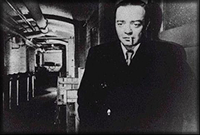 Der
Verlorene
Der
Verlorene |
|
During
the 1950s health problems caused Lorre
to take fewer roles, although upon
returning to the U.S. he did expand
his repertoire with a musical, Silk
Stockings (1957) and several comedies.
His comedic talent was displayed in
a 1960’s series of comedy/horror for
American International Pictures. His
precise timing and droll delivery
in The Raven (1963) suggested that
Hollywood never fully explored Lorre's
range as an actor. |
He
was found dead on March 23, 1964,
having suffered a fatal stroke at
the age of 60.
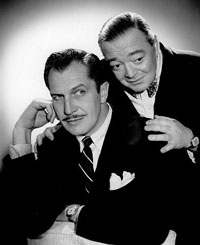
To
Vincent Price at Bela Lugosi’s funeral:
"Do you think we should drive a
stake through his heart just in
case?"
BIBLIOGRAPHY
The Films of Peter Lorre (Citadel
Press 1982) by Youngkin, Bigwood
and Cabana
The
Complete Directory to Prime Time
Network and Cable TV Shows (Ballantine
Books 1995) by Tim Brooks and Earl
Marsh
The Complete Actors Television Credits
1948-1978 (Second Edition Vol. 1:
Actors) by James Robert Parish and
Vincent Terrace
Television Drama Series Programming:
A Comprehensive Chronicle (47-'59
and 59-'75) by Larry James Giankos
Television Comedy Series: An Episode
Guide to 153 TV Sitcoms in Syndication
by Joel Eisner and David Krinsky
|
    
You
have reached http://www.eviltwin.velvetsofa.com/Lorre/peter.html
To
comment on the content of these
pages, please write to:
lorre@eviltwinltd.com
 Torrance
Lasik
Torrance
Lasik


These
pages are Copyright 1996-2006 Teresa
and/or Tracy Murray (T 'n' T). Page
design is entitled "Sinister
Star". These pages are completely
unofficial in nature. They are not
intended to infringe on the rights
of any company, studio, author or
miscellaneous individual who might
hold rights to any image or intellectual
property herein. They are certainly
not making a profit.
|
|
|
|
|
|

